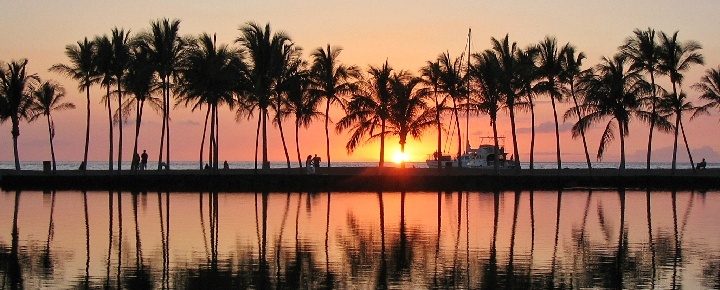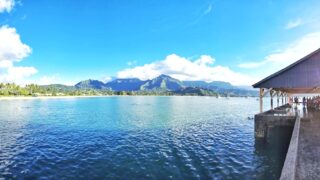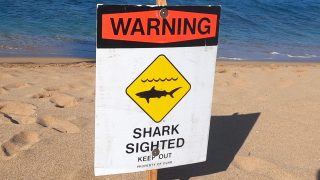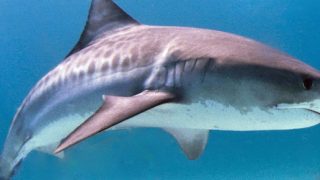Sharks in Hawaii continue to make the news after a Utah visitor was bitten twice this week by a shark as he swam on the Big Island. The 62-year-old man was about 600 feet offshore when the shark first bit his left hand, then bit him again in the left leg as he tried to fight it off. That was according to the state DLNR Division of Aquatic Resources.
Is it safe to be swimming 600 feet from shore? We wouldn’t do it ourselves; you may feel differently. At Hanalei Bay Kauai, people often swim away from the beach into the bay instead of along the shoreline. When you venture out far in the ocean, you’re far from an easy rescue should anything go awry, with sharks not even being among the first concerns.
Luckily, the man was able to hail a catamaran that was nearby. The boat took him to shore. First responders assisted and then transported him to the hospital.
Additional information about the attack isn’t currently available. When asked, DLNR said, “Under established protocols, DLNR does not release victims’ names, the extent of injuries, or medical condition.”
Shark warning signs were placed following Sunday’s incident. Later on Monday, however, they were removed at Big Island’s Anaehoomalu Bay. Ocean and aerial observation did not spot any sharks in the area.
“A-Bay,” as it is often called, has had a number of shark attacks, including one as recently as three months ago. It’s famous for snorkeling and other ocean activities. The location is nearby the resort area of Waikoloa.
Hawaii shark bites remain rare.
On average, shark bites in Hawaii average 3-4 per year. That is in relation to some 10 million annual Hawaii visitors. The expression about being more likely struck by lighting comes to mind here. Serious shark bites are even more rare.
Shark-safer Hawaii beaches.
No beach in Hawaii is immune from sharks entirely, so that notion might as well be removed from visitor thinking. That having been said, some beaches have far fewer occurrences of shark attacks. You can also visit the Hawaii Shark Incidents List from DLNR to see current or past problems at beaches throughout Hawaii.
Some of the safer locations often mentioned include:
Waikiki Beach, Oahu. That’s still true even though sharks were spotted in the water with swimmers just last month.
Poipu Beach, Kauai. Last summer, however, lifeguards advised beachgoers to stay out of the water there as a 6 to 8-foot shark was sighted near the Tombolo. Shark warning signs were posted.
Napili Bay, Maui.
Kapalua Bay, Maui.
Hapuna Beach, Big Island. In 2015, a 58-year-old Kansas visitor was bitten while snorkeling there. When it occurred, he was about 100 feet from shore in water 4-5 feet deep.
In 200 years, just 184 Hawaii shark attacks.
That is based on information from the International Shark Attack File, the only comprehensive source of shark attacks, including those in Hawaii.
Most shark attacks in Hawaii have been by tiger sharks, which can be aggressive and curious. These are among the three most dangerous sharks worldwide.
As a reminder, Hawaii DLNR reminds all of us that shark attacks in Hawaii are very rare:
The chances of being bitten by a shark are less than one in a million. And the chances of a serious injury are much less.
Shark-safety guidelines.
- Swim with others and at lifeguarded beaches.
- Avoid swimming far from the shoreline.
- Don’t swim or surf near river mouths. These are areas to which sharks are attracted.
- When sharks are the most active, avoid swimming or surfing at dawn, dusk, or night.
- Don’t wear bright jewelry or clothing since they may attract and confuse sharks.
- Finally, leave the water immediately if you see a shark (no problem!) and notify lifeguards or other authorities.
And finally, #7 is to pay attention to warning signs. Look at this video from DLNR at A-Bay last year after a shark incident. Watch and see people ignore warning signs and enter the ocean. We recommend staying safe and waiting for the signs to be removed (which happens 24 hours after a shark sighting or incident).
Read more about the real danger of sharks in Hawaii. Have you ever seen a shark during your Hawaii vacation?







Very interesting topic.
We’ve snorkeled all over Hawaii and the Great Barrier Reef in Australia.
Always followed the safety recommendations.
Bill has always said the snorkeling off the beach at our timeshare @ Westin Kaanapali is as great as anywhere We’ve been. Snorkeled there dozens of times
He’s always had a respect for sharks but a deep fear of them.
In the last few years West Maui has had some tragic attacks and that really scared him.
Still going swimming near the shore with lots of people around but thanks to being 70 soon and Spielberg’s Jaws movie and worse that music in his head, jumping back into the pool and water slide is alot more safe and fun !!
Ah ! To be 70 and cautious isn’t so bad !!
Aloha everyone, Hawaii is gorgeous !
As a comparison a half mile off shore is 2640 ft-600 ft off shore is not very far,often the water is clearer and many swimmers enjoy looking at the reef
Swimming 600 ft off shore is alarming in itself. What purpose does it serve? What do you do that far out,that you can’t do 100 ft from shore? Perhaps if you were spear fishing or something. But there have been shark attacks much closer to shore as well. I know they always tell us that shark attacks are “rare.” Rare but still devastating to victims. What could possibly be done to keep sharks away? A series of nets perhaps? Then we’ll see swimmers being caught up in them. Electronic repelling? We have to understand that we’re the visitors in sharks territory. What seems to be attracting these sharks? Is it that the sharks are feeding on baitfish that are closer to shore now for some reason? Scary to see them in populated areas like Waikiki.
Thanks for you newsletters! I’m a frequent visitor to the Islands. Re shark and other swimming safety, information frequently reference a number of yards from the shore (100, 600,etc.). Any chance you can post something that gives us a visual reference? I think it’s tough for most of us to estimate number of yards in distance, especially looking across water and from shore out across water, OR when we’re IN the ocean and trying to guage how close or far from shore we are. Many thanks!
Hi Kimberly.
Thank you! We aren’t sure what we could even offer regarding measuring yards from shore. Maybe someone else can give us a hand.
Al0ha.
Hoping someone can weigh in with a trick to estimate “yards distance” from the shore, and when in the water, back to shore.
Not specifically a shark concern though…. there are other references to 100 yards, 500 yards etc. in general ocean/beach safety cautions.(how far can lifeguards see? lifeguards have to be able to swim 500 yards in 10 minutes – am I too far out for a lifeguard?…) So I’m wondering if anyone can pitch in with something like, “the south reef at Ulua beach extends x yards from shore and is visible above water for x yards”, or use other major landmarks at various beaches for visual ref. ??
An American football field is 300 ft long from goal line to goal line (no end zone). So Two (2) football fields long? That’s a reference many could understand?
Just returned from 2 months of seal volunteering on Kauai and had 2 shark sightings in that time at Poipu Beach in the evening after the lifeguards had left. Right at sunset. At least 2 sharks each sighting, 5-7 feet long, near shore, maybe 10-15 feet out in shore break. Lifeguards were informed the morning after each occurrence. Interesting note- one of our volunteers actually once saw a monk seal enter the water and chase a shark out of the area. Amazing!
This is a public service announcement to all visitors who enjoy swimming in the ocean:
1. The ocean is the natural habitat of the shark.
2. The shark is a carnivorous (i.e. meat-eating) predator.
3. You are made of meat.
Thank you.
It’s a false sense of security to believe that if you swim near shore you will never have a shark encounter,just like it is a false sense of security to believe that attacks only happen in murky water. It’s human nature to find blame when something happens,”he was swimming too far off shore” or,”the water was murky” or”it was her fault the seal attacked her because she swam too close “. Many swimmers like myself swim in the open ocean,we are willing to accept the risks without being guilted-because many open water off shore swimmers believe that the most dangerous thing we do daily is to drive.
I was at A Bay that day in December at the Marriott entrance and I did see people in the water. I was surprised and thought about how crazy they were. I spent a lot of time at A Bay this February and saw so many people quite far out in the water swimming, snorkeling and paddle boarding. I guess it was only a matter of time that an attack would happen again.
One item I didn’t see on the list is staying out of the ocean after heavy rains (like what have been happening a lot this winter) so as to avoid brown water conditions. You can’t see the sharks but they can see and sense you.
Yikes, the lovebigisland site actually encourages snorkelers to go out >500 feet on that beach for the best reef fish viewing
lovebigisland.com/big-island-beaches/anaehoomalu-beach/
Er no I wouldn’t swim that far off shore, not even here in England 🙂
Whilst redirecting and marvelling at sharks so do unfortunately have an unhealthy fear of them thanks to seeing Jaws as a child.
I am therefore more aware of entering their territory although it doesn’t stop me but it’s always on my mind.
Having only been fortunate enough to visit your beautiful islands once before I am hoping our family can visit again this summer and wanted to ask, do you know if sharks can/do enter the lagoons on Oahu around Ko Olina?
As a general rule of thumb, and this applies worldwide, I believe, if it is saltwater, there may be sharks in it. I don’t mean to be glib or snarky, but I don’t think there’s any ocean water that is shark-free. That said, there are places where sharks are very rare, and by the looks of it, I would assume the lagoon at Ko Olina is one of them. I would also assume that the resorts are pretty proactive about keeping people as safe as they can. As always, YMMV.
I don’t think shark attacks have anything to do with how far from shore a swimmer swims,I’ve seen photos of sharks near the shoreline in crystal clear water.
Most shark attacks are on 3 feet of water but that is because that’s where most people are. The further out you swim the deeper you go into their territory but it does sound like being in the wrong place at the wrong time as we aren’t their normal food source so you’d either be mistaken for something else, come across a curious shark of a hungry one.